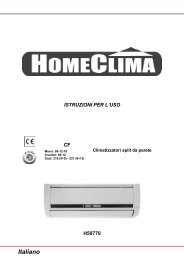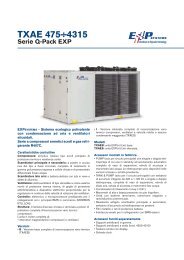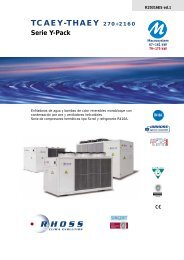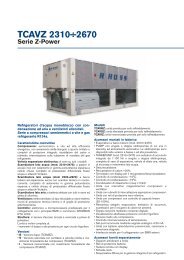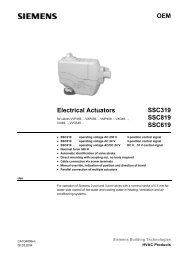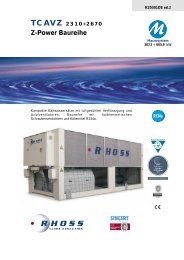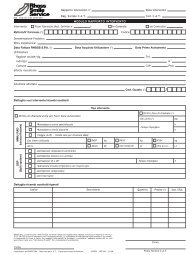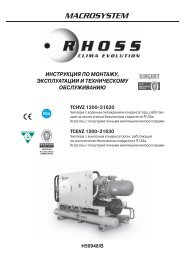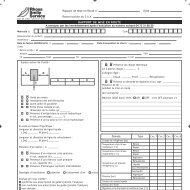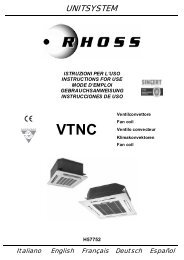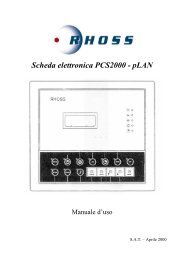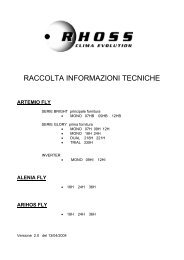tcaes 230÷4160 thae - Rhoss
tcaes 230÷4160 thae - Rhoss
tcaes 230÷4160 thae - Rhoss
Create successful ePaper yourself
Turn your PDF publications into a flip-book with our unique Google optimized e-Paper software.
SECTION II: INSTALLATION AND MAINTENANCE<br />
Electrical connection of a motor-driven<br />
pump/secondary circulation pump (VERSION PU-<br />
PU/DP)<br />
DANGER!<br />
Electrical connection must be carried out by<br />
qualified personnel in compliance with the<br />
regulations in effect in the country where the unit is<br />
installed. RHOSS shall not be held liable for<br />
damage to persons or things caused by incorrect<br />
electrical connection.<br />
IMPORTANT!<br />
Refer to the wiring diagrams enclosed with the unit<br />
which highlight the terminals to be set up by the<br />
installer.<br />
If one of the pumps stops running, act on the<br />
backup pump selector on the control board to<br />
enable the backup pump.<br />
II.2.5 REMOTE MANAGEMENT USING<br />
CONNECTIONS SET UP BY THE INSTALLER<br />
DANGER!<br />
Electrical connection must be carried out by<br />
qualified personnel in compliance with the<br />
regulations in effect in the country where the unit is<br />
installed. RHOSS shall not be held liable for<br />
damage to persons or things caused by incorrect<br />
electrical connection.<br />
IMPORTANT!<br />
Refer to the wiring diagrams enclosed with the unit<br />
which highlight the terminals to be set up by the<br />
installer.<br />
SCR - Remote control selector.<br />
SEI – Remote summer-winter selector (THAE-THAES only)<br />
LF – Compressor function lamp.<br />
LB – General malfunction lamp.<br />
• Remote ON/OFF enablement (SCR)<br />
Remove the jumper between the terminals (35 and 36 on models<br />
TCAE-TCAES-THAE-THAES 470÷4160, 21 and 22 on models TCAE-<br />
TCAES-THAE-THAES 230÷260) on the user interface terminal board<br />
and connect the remote control ON/OFF selector cables.<br />
CAUTION<br />
Open contact: the unit is OFF.<br />
Closed contact: the unit is ON.<br />
IMPORTANT!<br />
When the unit is switched OFF using the remote<br />
control, E00 is displayed.<br />
II.2.6 NOISE REDUCTION<br />
IMPORTANT!<br />
The unit is designed for outdoor installation;<br />
therefore local and national standards in force<br />
regulating noise levels must be complied with.<br />
Incorrect positioning or installation may cause an<br />
amplification of the noise or vibrations produced<br />
while the unit is running.<br />
○ During installation it is IMPORTANT to bear in mind the following:<br />
• non-soundproofed reflecting walls near the unit (such as balcony<br />
walls or the perimeter walls of a building), may increase the total sound<br />
pressure level reading near the appliance by as much as 3 dB(A) for<br />
every surface (e.g. 2 corner walls cause an increase of 6 dB(A);<br />
• install suitable vibration-damping supports under the unit to avoid<br />
transmitting vibrations to the building structure;<br />
• rigid frames may be installed on the top floor of the building to<br />
support the unit and transmit its weight to the load bearing structures of<br />
the building;<br />
• carry out all water connections using elastic joints. Pipes must be<br />
firmly supported by solid structures. If the pipes are routed through<br />
walls or panels, insulate with elastic sleeves.<br />
○ If there are any structural vibrations in the building (after the unit<br />
has been installed and has started to run) which provoke such strong<br />
resonance that noise is generated in other points of the building, consult<br />
a qualified acoustic technician for a complete analysis of the problem.<br />
II.3 OPERATION AND ADJUSTMENT<br />
II.3.1 CONTROL BOARD<br />
The control board features a general isolator with door interlock. The<br />
230 V auxiliary circuit power supply and the 12 V control power supply<br />
is shunted internally by the three phase power supply. The layout of<br />
electrical components in the control board is illustrated in Fig. 7 and Fig.<br />
8.<br />
CE1 = microprocessor controller<br />
IA = auxiliary switch<br />
IC = compressor switch<br />
IG = main switch<br />
IV = fan switch<br />
KC = compressor contactor<br />
KV = fan contactor<br />
TR = transformer<br />
IP = accumulation pump switch<br />
KP = accumulation pump contactor<br />
MF = phase monitor<br />
Control board layout on TCAE-TCAES-THAE-THAES 230÷260 units<br />
• Remote Summer/ Winter enablement on THAE-THAES (SEI)<br />
Change parameter H49 (from 0 to 1) and connect the remote<br />
Summer/Winter selector cables between the terminals (33 and 34 on<br />
models THAE-THAES 470÷4160, 19 and 20 on models THAE-THAES<br />
230÷260) on the user interface terminal board.<br />
CAUTION<br />
Open contact: heating cycle.<br />
Closed contact: cooling cycle.<br />
IMPORTANT!<br />
When the unit is switched OFF using the remote<br />
control, E00 is displayed.<br />
• LF-LB lamp remote control<br />
To remote control the two signals, connect the two lamps according to<br />
the instructions provided in the wiring diagram supplied with the<br />
machine.<br />
Fig. 7<br />
12



